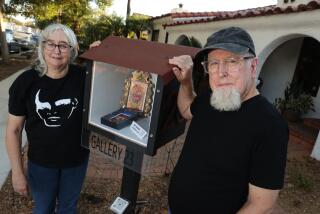Ethnic Litmus Test a Problem for American Indian Artists : Arts: A federal law requiring verification of membership in a state or federally recognized tribe creates problems for some.
- Share via
As chief curator of the Southwest Museum, Kathleen Whitaker defines her job as bringing the work of American Indian artists, who typically have difficulty breaking into mainstream galleries, to the attention of collectors. But for the first time in the Southwest’s 80-year history, the museum must ask a question that some are saying makes institutions specializing in American Indian art more exclusive than restricted country clubs:
“Are you really an American Indian and can you prove it?”
“For a white person, this is embarrassing to ask,” said Whitaker, who was required by federal law to verify all 45 artists exhibiting in the museum’s Urban Indian Art Exposition opening at the museum today and continuing through Sunday. “It smacks a bit of, ‘Should I have my number tattooed on my arm?’ ”
Because of the Indian Arts and Crafts Act of 1990, Whitaker and other museum curators have to get over their awkwardness and ask this question every time they want to show for sale any American Indian’s arts and crafts. Artists unable to answer the question with proof of their membership in a state or federally recognized tribe are finding museums and galleries unwilling even to look at their work.
Reps. Jon Kyl (R-Ariz.) and Ben Knighthorse Campbell (D-Colo.) sponsored the act to block what they see as a steady stream of fake American Indian necklaces, beaded bags and paintings flooding the market.
“It’s the only ethnic art form in the United States that is badly plagiarized,” said Campbell, a Cheyenne who is the only American Indian in Congress, and also a jeweler. “Arts and crafts are one of the most important industries on reservations. This is also a consumer protection bill: When people buy Indian art they have a right to know that an Indian made it.”
No one has been prosecuted by this law, mostly because Congress hasn’t given money for the regulations to be written, but museums and galleries aren’t waiting. Jittery museum boards of directors have consulted lawyers and set their own standards to avoid trouble. Although the act was written to apply to art for sale only, museums are reluctant to exhibit artists without proof of tribe membership. Exhibitions in San Francisco and Santa Fe have shut down, as museums--especially small, nonprofit institutions--fear losing their tax-exempt status. They also face stiff penalties, ranging from $250,000 for artists to $1 million for institutions.
At stake is the estimated $400 million to $800 million that American Indian-style arts and crafts earn annually, according to a 1985 Department of Commerce report. The report estimated that fake American Indian art manufactured in places like Hong Kong, Taiwan and Mexico siphons $40 million to $80 million away from American Indians annually.
“The native people can’t compete with the manufacturer in Taiwan. The act is to protect us,” said Michael Horse, a Los Angeles-based artist who is part Zuni, Apache and Yaqui. Most sources agree that all mass-produced arts and crafts should have labels declaring the country of origin. However, the most controversial portion of the act is that which affects anyone who makes art for sale and who says he or she is American Indian.
For American Indians who have never been associated with a reservation, proving membership in a tribe can be difficult and demeaning. According to Richard Glazer-Danay, a commissioner on the federal Indian Arts and Crafts Board, there are American Indian groups not recognized by federal or state governments, such as the Northfork Mono Indians from the Yosemite area. Some tribes never entered into relationships with the government out of fear and protest over the establishment of reservations.
California has 100 recognized tribes, according to the Sacramento office of the Bureau of Indian Affairs. But in the 1990 Census, only 48,000 out of the 242,164 who said they were American Indians are officially registered with a recognized tribe in California. Complicating matters are the different standards each tribe sets for membership. Some tribes want members to have a certain percentage of American Indian blood. Others only recognize those whose mothers are tribal members.
Not only are membership rules complex, but the act attempts to legislate an old issue among American Indians--who is real and who isn’t. Glazer-Danay, who is part Mohawk and part Jewish, defends the law as an effective way to keep the integrity of Indian cultures.
“Everyone says they are part Cherokee,” said Glazer-Danay. “We are the only group that has a romantic attachment. Who has the authority to decide what your culture is? The whole view of what is Indian is often (determined) by a phony.”
Many American Indian artists who are members of tribes object to having to show cultural credentials in order to sell art. One artist, who wished not to be named, said he burned his Bureau of Indian Affairs card in protest.
“It’s turned into a witch hunt,” said Horse, who is participating in the Southwest Museum show and sale. Although Horse agrees with the spirit of the act, he says it doesn’t take into account the complexity of American Indian history. “I have many native friends who don’t have documentation. They are really good native artists whom it’s going to hurt.”
Andrew Alvarez, a Long Beach jeweler for 25 years, is part Indian and part Mexican. At a crafts fair two weeks ago, Whitaker saw Alvarez’s work for the first time and expressed interest. But then she asked if he could prove membership to a tribe. He couldn’t. It was the first time he was excluded from an exhibition.
“It’s difficult to deal with this,” said Alvarez. “I don’t know what to do at this point. I’m still Indian. I’m just as much as anyone else.” He said that he is in the process of obtaining membership in the Navajo tribe, but “it’s nothing you just go down and do. It takes months and months. For people not born and raised on the reservation, this is hard.” In the meantime, he advertises his jewelry as Indian-style or Southwestern style.
Whitaker said she knows of five other artists who didn’t submit their work to the Urban Indian Exposition once they learned of the membership requirement. Although she supports the spirit of the act, Whitaker worries that urban American Indian artists, who have a history of being cut off from reservations, will have more difficulty proving their association with a tribe.
Despite the lack of enforcement, the act has already had ramifications. One artist withdrew from a show at the Natural History Museum in Los Angeles in the spring of ‘91, when he did not have proof of tribal membership. The San Francisco American Indian Contemporary Art Museum closed a show last summer by sculptor and multimedia artist Jimmie Durham when someone said that he wasn’t an American Indian. Durham, who says he is of Cherokee heritage, is not a registered member of the tribe. The museum, a small nonprofit, was afraid of being fined and closed his show.
The museum’s curator, Janeen Antoine, said that while this may have been an overreaction, “people are afraid of showing Indian art now and getting slammed with severe penalties.”
“We don’t want to be art police,” Antoine said. “Cultural values aren’t transmitted through federal sanction. The bottom line is that someone will buy art by the quality of the work, not if someone’s carrying a card.”
More to Read
The biggest entertainment stories
Get our big stories about Hollywood, film, television, music, arts, culture and more right in your inbox as soon as they publish.
You may occasionally receive promotional content from the Los Angeles Times.










